Food and drink in Brittany bis Posted by Tim Hildreth on Sep 12, 2017 in Culture, Vocabulary
Last month as I got ready for my trip to France I put together a post about some of the things I was looking forward to eating and drinking while I was in Paris and la Bretagne (Brittany). I’m happy to report that my culinary trip was a success . . . and included so many more of my favorites that I didn’t include in my first report, that I thought a little follow up was in order.
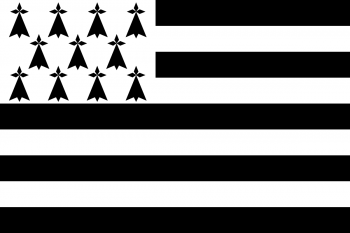
First of all, I’m sure you’ll be glad to know that I was able to enjoy each of the items I listed in my previous post. I might even have had the best galette ever at a quaint little crêperie in the southern Brittany city of Vannes.
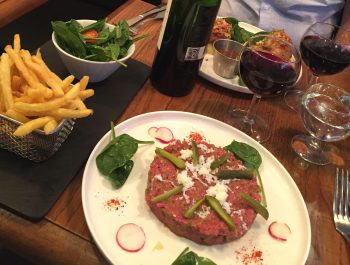 Steak tartare
Steak tartare
On our first night in Paris I enjoyed a meal of steak tartare (finely chopped raw steak prepared with an egg, mustard and other spices, and served (often) with pickles or capers). It might be surprising (to my American readers at least) but this raw meat dish is very common on café and bistro menus throughout France. It’s a dish that I almost never order outside of France, but that I always enjoy at least once when I’m there*.
Des œufs mayonnaise 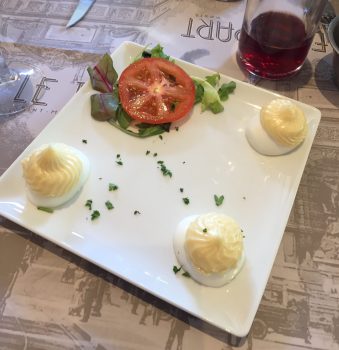
Hard-boiled eggs with house-made mayonnaise is a favorite entrée found on many menus. It’s a simple dish, but an almost perfect pairing. The secret is in the mayonnaise. A hard-boiled egg is pretty easy to master…and not really all that interesting…but when you pair it with a perfectly creamy-yet-tart, fresh-made mayonnaise, it’s simply delicious. I’ll admit the presentation of mine was a little odd (I suspect they could have used a smaller assiette / plate) but it was a perfect start to my meal.
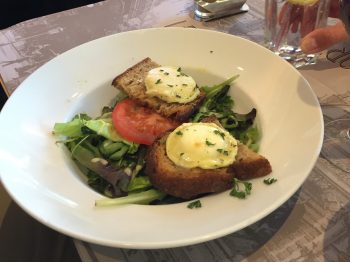 Salade de chèvre chaud
Salade de chèvre chaud
Another great entrée is une salade de chèvre chaud. Des crottins de chèvre (small round wheels of creamy goat cheese) are put on sliced bread, quickly broiled in the oven, and then served atop a simple green salad with a light mustard or a fruit vinaigrette. The warm, creamy cheese, the crunch of the toast, the coolness of the salad, and the tang of the vinaigrette are a perfect combo for opening up a meal and your appetite.
Jambon baguette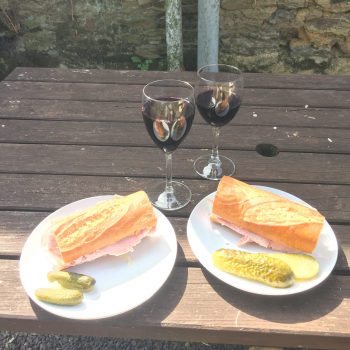
One of the advantages to renting a house for our recent trip was that we could shop and prepare our own meals. And while some of my French favorites (like foie gras or salade de chèvre chaud) can seem a bit fancy, my absolute French favorite is about as simple as it gets so I could indulge in it almost every day. With a ready supply of French bagutettes, good French jambon (ham), des tranches d’Emmental (thin slices of Emmental cheese), and of course frech local beurre (butter) I had at least one sandwich jambon baguette a day while on vacation! [For my Amercian readers: I haven’t had time to follow up personally, but my ex-wife assures me that hefty slices of Virginia Baked Ham are a close substitute for delicious jambon blanc / jambon de Paris that makes French ham-and-cheese sandwiches so good!)
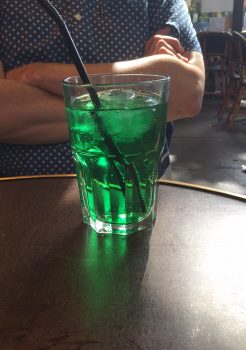 Un Diabolo menthe
Un Diabolo menthe
France is know for wine and Brittany has le cidre (cider), but if you want something refreshing without alcohol to cool off on a hot day, try un Diabolo menthe. This drink made with French limonade (carbonated, lightly flavored natural soda) and mint syrup is a perfect cooler for those hot afternoons. It’s been one of my favorites since my first trip to France. If you want to try and make your own but you can’t get authentic French limonade, I have found that Sprite and creme de menthe (non-alcoholic!) syrup makes a passable substitute.
* Because there are risks with eating raw or rare meat**, you should only try steak tartar if you are sure of the quality of the establishment.
** Another important thing to note if you’re dining out in France: The French as a general rule like their red meat on the rare side. I almost always find that steaks, chops, etc. are less cooked in France than they are in the US and many other countries. French terms for ‘doneness’ of meat are: bleu (lit. ‘blue’; basically barely cooked at all); saignant (lit. ‘bloody’; very, very rare); a point (medium, though as implied by my comments, this is closer to what Americans would consider rare); and bien cuit (lit. ‘well cooked’; if you order a piece of steak ‘bien cuit’ don’t be surprised if the waiter makes a face!)

Build vocabulary, practice pronunciation, and more with Transparent Language Online. Available anytime, anywhere, on any device.



